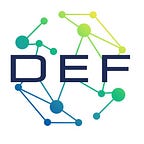Innovating from the Inside
By Kathy Trimble
Disruptive Thinkers curates blog posts that promote a culture of innovation in the national security community, inspiring and connecting ideas that challenge the status quo. We welcome submissions that are in line with this mission.
In the fall of 2018, I was asked to moderate a group discussion at the Defense Entrepreneurs Forum (DEF) annual conference in Denver, Colorado. I was looking to get more involved in the organization and contribute to the wider community. The group discussion I led was “Innovating from the Inside.”
How do you innovate from the inside, particularly in national security?
It depends. It’s difficult. And while there is no one-size-fits-all approach to innovation, there are tools and lessons learned to observe.
Soon after, I accepted a leadership position within the organization as the National Programs lead. After serving for one year, I stepped down on January 1st, 2020, confident that the important work will continue to change the culture of innovation in the national security community.
The success of DEF comes from its members and all-volunteer staff. It is truly a learning organization, ever evolving and adapting and growing.
Here are some thoughts on innovating from the inside.
Technology is the answer, unless it isn’t
Defense innovation and technology are often used synonymously. Before assuming a technology solution to your problem, take the time to understand the root cause of your problem.
- What is the problem you are addressing?
- Is it a strategy or planning issue?
- Is it about education? Is there a misunderstanding or lack of awareness?
- Is it structural or organizational? Is it about policies, regulations, or a workforce issue?
- Is it technical? What capability is lacking? And if you acquired a technology solution, do you have the capacity to execute and sustain it?
Innovation as a portfolio
Assignments, rotations, and budget cycles tend to drive near term decisions in national security ecosystems. These 2–5 year cycles tend to drive innovation initiatives into projects. Long term change requires longer term planning, and a portfolio perspective may be an approach.
- Projects are executed; portfolios are managed.
- Projects begin and end; portfolios are thought of in terms of risk and opportunity.
Find champions and believe naysayers
As important as finding advocates and champions is listening and understanding the reasons why innovation is not happening. Sometimes the innovation is not necessary; some processes and efforts are needed and working as intended. But sometimes it is necessary! It’s easy to dismiss the negativity as personal or organizational.
- What is the feedback, positive or negative, telling you?
- Can you create opportunity from this?
Be flexible with your pitch idea
I’ve heard this from several private sector investors. The enthusiasm for a single solution to a problem sometimes leads to myopia. So while you may think your solution answers a problem, there may be other opportunities.
- Take feedback and think about other solution sets not just for your unit, your service, or your agency.
- Be open to being trained to “pitch” and sell your idea/concept.
Innovation ecosystems and alignment
Let’s say you are successful in establishing an innovation project or effort within your organization. What’s next? Sustaining the effort and instilling a culture of innovation require long term planning.
- How does the innovation effort align with your organization’s core mission? Is it complimentary? Is it a shift from the current model?
- Where do experiments and prototyping efforts fit into your overall investment strategy?
- What are the opportunities and risks?
- What might be some unintended consequences of changing resource models?
People
While technology gets a lot of credit, people are your most important resource. It is vital to be mindful of the talent and needs of the people around you.
- Do you have the right people?
- Are you connected to the right people?
- What does your dream team look like?
- How do you think about cost?
- How willing are you to irritate many but inspire a few?
- How much time and resources do you have to execute and sustain an effort?
Remember to acknowledge the innovator and also recognize the leaders and advocates who championed the effort.
Kathy Trimble is currently a Vice President at the Council on Competitiveness. She’s a former Department of Defense civilian who started her career in the defense industry. She’s always the one asking ‘why?’
The Defense Entrepreneurs Forum is a 501(c)(3) non-profit that inspires, connects and empowers people by convening events, forging partnerships and delivering tangible solutions. Our mission is to promote a culture of innovation in the U.S. national security community.
If you are a civil servant, military member, academic, entrepreneur, policymaker, or technologist (or just find the idea of helping solve tough problems enticing), we’d love to have you join the DEF Community!
